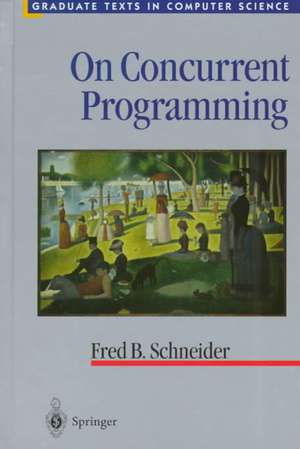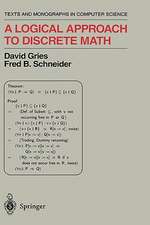On Concurrent Programming: Texts in Computer Science
Autor Fred B. Schneideren Limba Engleză Hardback – 6 mai 1997
| Toate formatele și edițiile | Preț | Express |
|---|---|---|
| Paperback (1) | 342.28 lei 43-57 zile | |
| Springer – 30 sep 2012 | 342.28 lei 43-57 zile | |
| Hardback (1) | 348.89 lei 43-57 zile | |
| Springer – 6 mai 1997 | 348.89 lei 43-57 zile |
Din seria Texts in Computer Science
- 20%
 Preț: 366.94 lei
Preț: 366.94 lei - 20%
 Preț: 675.36 lei
Preț: 675.36 lei - 20%
 Preț: 411.53 lei
Preț: 411.53 lei - 20%
 Preț: 411.75 lei
Preț: 411.75 lei - 20%
 Preț: 306.37 lei
Preț: 306.37 lei - 20%
 Preț: 474.58 lei
Preț: 474.58 lei - 20%
 Preț: 1244.39 lei
Preț: 1244.39 lei - 20%
 Preț: 370.59 lei
Preț: 370.59 lei - 20%
 Preț: 379.65 lei
Preț: 379.65 lei - 20%
 Preț: 444.93 lei
Preț: 444.93 lei - 20%
 Preț: 305.31 lei
Preț: 305.31 lei - 20%
 Preț: 406.21 lei
Preț: 406.21 lei - 20%
 Preț: 503.88 lei
Preț: 503.88 lei - 20%
 Preț: 370.23 lei
Preț: 370.23 lei - 17%
 Preț: 366.70 lei
Preț: 366.70 lei - 20%
 Preț: 423.53 lei
Preț: 423.53 lei - 20%
 Preț: 441.71 lei
Preț: 441.71 lei - 20%
 Preț: 515.36 lei
Preț: 515.36 lei - 15%
 Preț: 637.58 lei
Preț: 637.58 lei - 20%
 Preț: 353.34 lei
Preț: 353.34 lei - 20%
 Preț: 356.82 lei
Preț: 356.82 lei - 20%
 Preț: 181.92 lei
Preț: 181.92 lei - 20%
 Preț: 330.42 lei
Preț: 330.42 lei - 20%
 Preț: 743.62 lei
Preț: 743.62 lei - 20%
 Preț: 663.45 lei
Preț: 663.45 lei -
 Preț: 457.75 lei
Preț: 457.75 lei - 20%
 Preț: 536.66 lei
Preț: 536.66 lei - 20%
 Preț: 358.24 lei
Preț: 358.24 lei -
 Preț: 385.84 lei
Preț: 385.84 lei - 20%
 Preț: 394.57 lei
Preț: 394.57 lei - 20%
 Preț: 344.76 lei
Preț: 344.76 lei - 20%
 Preț: 621.18 lei
Preț: 621.18 lei - 20%
 Preț: 350.86 lei
Preț: 350.86 lei - 20%
 Preț: 339.95 lei
Preț: 339.95 lei - 20%
 Preț: 588.21 lei
Preț: 588.21 lei - 20%
 Preț: 199.57 lei
Preț: 199.57 lei - 20%
 Preț: 341.30 lei
Preț: 341.30 lei - 23%
 Preț: 726.94 lei
Preț: 726.94 lei - 20%
 Preț: 325.30 lei
Preț: 325.30 lei - 20%
 Preț: 595.80 lei
Preț: 595.80 lei - 20%
 Preț: 593.48 lei
Preț: 593.48 lei -
 Preț: 454.31 lei
Preț: 454.31 lei
Preț: 348.89 lei
Preț vechi: 436.12 lei
-20% Nou
Puncte Express: 523
Preț estimativ în valută:
66.78€ • 72.56$ • 56.13£
66.78€ • 72.56$ • 56.13£
Carte tipărită la comandă
Livrare economică 21 aprilie-05 mai
Preluare comenzi: 021 569.72.76
Specificații
ISBN-13: 9780387949420
ISBN-10: 0387949429
Pagini: 473
Ilustrații: XIX, 473 p.
Dimensiuni: 155 x 235 x 37 mm
Greutate: 0.87 kg
Ediția:1997
Editura: Springer
Colecția Springer
Seria Texts in Computer Science
Locul publicării:New York, NY, United States
ISBN-10: 0387949429
Pagini: 473
Ilustrații: XIX, 473 p.
Dimensiuni: 155 x 235 x 37 mm
Greutate: 0.87 kg
Ediția:1997
Editura: Springer
Colecția Springer
Seria Texts in Computer Science
Locul publicării:New York, NY, United States
Public țintă
ResearchCuprins
1 Introduction.- 1.1 Concurrent Programs.- 1.2 Communication and Synchronization.- 1.3 Understanding Concurrent Programs.- 1.4 A Preview.- Historical Notes for Chapter 1.- Exercises for Chapter 1.- 2 Formal Logic.- 2.1 Formal Logical Systems.- 2.2 Propositional Logic.- 2.3 A Predicate Logic.- 2.4 Safety and Liveness Revisited.- Historical Notes for Chapter 2.- Exercises for Chapter 2.- 3 Temporal Logic.- 3.1 Informal Preview.- 3.2 Syntax and Meaning of Formulas.- 3.3 Axioms and Inference Rules.- 3.4 Temporal Logic Applications.- 3.5 About Modal Logics.- Historical Notes for Chapter 3.- Exercises for Chapter 3.- 4 Notation and Logic for Sequential Programming.- 4.1 Notation for Sequential Programs.- 4.2 Reasoning About Program States.- 4.3 Proof Outline Logic.- 4.4 Assignment to Composite Variables.- 4.5 A Predicate Transformer.- Historical Notes for Chapter 4.- Exercises for Chapter 4.- 5 Concurrency and Interference.- 5.1 Specifying Concurrency.- 5.2 Control Predicate Axioms.- 5.3 Interference Freedom.- 5.4 Hiding Control Predicates in Derived Terms.- 5.5 Synchronously Altered and Shared Assertions.- 5.6 Specifying Synchronization.- 5.7 Synchronization and Interference.- Historical Notes for Chapter 5.- Exercises for Chapter 5.- 6 Safety Properties: Invariance.- 6.1 Invariance Properties.- 6.2 Verifying Invariance Properties.- 6.3 Exclusion of Configurations.- 6.4 Direct Use of Proof Outlines.- 6.5 Developing Programs for Invariance Properties.- Historical Notes for Chapter 6.- Exercises for Chapter 6.- 7 Safety Properties with Past Terms.- 7.1 Historical Safety Properties.- 7.2 Past Extensions to Predicate Logic.- 7.3 Verifying Historical Safety Properties.- 7.4 Developing Programs for Historical Safety Properties.- 7.5 Auxiliary Variables.- 7.6 Some Cautions.- Historical Notes for Chapter 7.- Exercises for Chapter 7.- 8 Verifying Arbitrary Temporal Logic Properties.- 8.1 S-Temporal Logic Revisited.- 8.2 Unless Properties and Derivatives.- 8.3 Fairness Assumptions.- 8.4 Reasoning from Fairness Assumptions.- 8.5 Helpful Actions and Eventualities.- 8.6 Liveness for Mutual Exclusion.- Historical Notes for Chapter 8.- Exercises for Chapter 8.- 9 Programming with Fine-Grained Atomic Actions.- 9.1 Pretending Atomicity.- 9.2 Translation-Independent Reasoning.- 9.3 Implementing Condition Synchronization.- 9.4 Programming with the Subset.- 9.5 Synchronization and Interference Revisited.- 9.6 Interlock Instructions.- 9.7 Example: Barrier Synchronization.- Historical Notes for Chapter 9.- Exercises for Chapter 9.- 10 Semaphores, Locks, and Conditional Critical Regions.- 10.1 Semaphores.- 10.2 Change of Variable to use Semaphores.- 10.3 Binary Semaphores and Locks.- 10.4 Split Binary Semaphore Method.- 10.5 Conditional Critical Regions.- Historical Notes for Chapter 10.- Exercises for Chapter 10.- 11 Message Passing and Distributed Programming.- 11.1 Asynchronous Message-Passing.- 11.2 Synchronous Message-Passing.- 11.3 Derivation of Distributed Programs.- 11.4 Shared-Variable Representations.- Historical Notes for Chapter 11.- Exercises for Chapter 11.- 12 Putting It Together.- 12.1 On Languages.- 12.2 Principles for Verifying Safety and Liveness Properties.- 12.3 Proofs Only Increase Confidence.- 12.4 A Tool and Applications.- Historical Notes for Chapter 12.- References.














